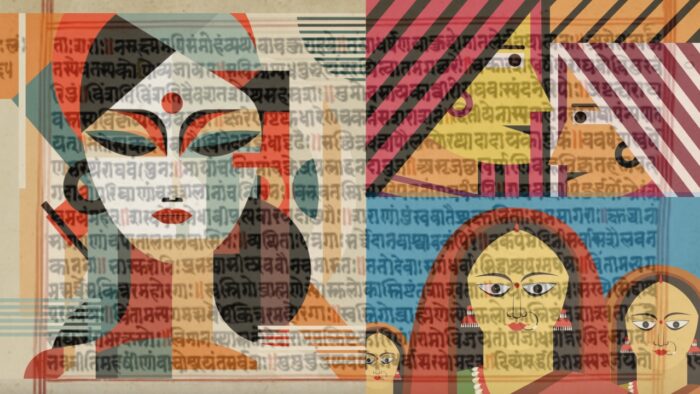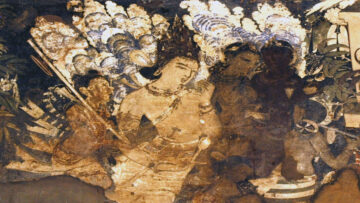(Seeing ‘Kaama’ Versus ‘Moksha Kaama’ in the Women Characters of Valmiki Ramayana through Modern Perspectives)
अस्य श्रीरामरक्षास्त्रोतमन्त्रस्य बुधकौशिक ऋषिः ।
श्री सीतारामचंद्रो देवता ।
अनुष्टुप छंदः। सीता शक्तिः ।
श्रीमान हनुमान कीलकम ।
श्री सीतारामचंद्रप्रीत्यर्थे रामरक्षास्त्रोतजपे विनियोगः ।
The inauguration of Sri Rama Janmabhoomi Teerth Kshetra at Ayodhya has filled us with a sense of joy and liberation. Now is also the time to celebrate the Rama Rajya that Sri Rama created through its means, values and virtues.
In this article, we will analyze some female characters from the Ramayana from the perspective of kaama (desire) and moksha kaama (liberation from desires) seeking to establish a connection to a general and proper understanding of some women from the epic “Ramayana”.
In India much of deep rooted gender specific ideas stem from generalized, vague and disseminated concepts found in our epics, especially Ramayana and the perception of women characters in Ramayana.
Therefore we will take a few characters and analyze them for their emotional values, social standing, intelligence, their own desire and identity in personal and social spheres in the general motif of kaama and moksha kaama. With each character we will try to emphasize them in a modern perspective of kaama and to see how these appropriations can lead to moksha kaama.
कौसल्या सुप्रजा राम पूर्वासन्ध्या प्रवर्तते ।
उत्तिष्ठ नरशार्दूल कर्तव्यं दैवमाह्निकम् ॥
The root of Rama Rajya and the benevolence of Rama as we see it, can be attributed mostly to Kausalya. Kausalya, a queen, shares her husband, king Dasharatha’s love with two other queens, Sumitra and Kaikeyi. Though Dasharatha says to Kaikeyi,
यदा यदा हि कौशल्या दासीवच्च सखीव च।।2.12.68।।
भार्यावद्भगिनीवच्च मातृवच्चोपतिष्ठति।
सततं प्रियकामा मे प्रियपुत्रा प्रियंवदा।।2.12.69।।
न मया सत्कृता देवी सत्कारार्हा कृते तव।
and acknowledges Kausalya like none else by giving Kausalya half the yagna nectar, Kaikeyi is his beloved queen and the object of his kaama.
When Rama decided to go on vanavas and Lakshmana says that he will capture Dasharatha, Kausalya asks Rama to consider what Lakshmana is saying because she understands the “dharma sankata” of Dasharatha, the dilemma between his ‘vachan’ to Kaikeyi and doing right to his subjects as they want Rama as their king. Kausalya’s ‘kaama’ is moksha kama and it is directed towards Rama’s return to the throne.
Kaikeyi is a brave warrior full of pride but not necessarily evil and she is the favorite of king Dasharatha. As we see, when Manthara out of her goodwill towards Kaikeyi, pressurizes Kaikeyi to demand that her son Bharata be anointed to the throne instead of Rama, she at first maintains that she sees Rama and Bharata equally. She even says Rama selflessly serves her even more than Kausalya. We wonder where this hidden pride is coming from and what was her general demeanor towards Kausalya. But when insinuated about the fact that she has been ignoring Kausalya and with Rama on the throne, she’ll take revenge on her, she becomes determined to put Bharata onto the throne. Kaikeyi being young and full of pride and chivalry doesn’t go back from asking her demands, and puts Dasharatha at the perils of Dharma. We observe that Kaikeyi’s kaama ignites the entire Ramayana, while awaiting Rama’s return gives her moksha kaama.
Both Kausalya and Kaikeyi possess streaks of self will, steadfastness and nyaya in Ramayana. Along with Sumitra, the three of them together represent internal politics of a joint family and play a pivotal role in steering the direction of the epic. We can appreciate an insight into dharma and kaama with these three powerful women who can be interpreted as satwa, rajah, tamah guna who are equally qualified to get moksha. The intersection of these three women propels and steers Ramayana.
Lakshmana’s wife Urmila on the other hand was insisted upon by Lakshmana himself to stay back and take care of his aging parents. A popular folklore idiom, ‘Urmila abhyanga’ as it is known, conveys the idea that Urmila took bath till Lakshmana came back, acknowledging her long wait and resilience. There’s a subjugation on her part, a social reclination, a social demeanor of her psyche, rooted in the socio-political identity of women that dictates what to do and when and at which situation. In the entire Ramayana, she silently represents suppressed kaama as a tapaswini which makes her the representation of moksha kaama while awaiting the return of Rama and Lakshamana.
In Aranya kanda, we have among us, a very simple minded yet diplomatic when necessary, fearsome ‘rakshasi’ Surpanakha. In the beginning, both Rama and Lakshmana made a mockery of her unnecessarily by insinuating embarrassing remarks, and this resulted in her nose being cut..
ततश्शूर्पणखां रामः कामपाशावपाशिताम्।
स्वच्छया श्लक्ष्णया वाचा स्मितपूर्वमथाब्रवीत्।।3.18.1।।
The archetype of a woman acting as a concept-metaphor for insinuating war, as in case of Surpanakha, plays an important role in modern ideas regarding which characters are typically seen as generator of dissidence and we can question this appropriation through Surpanakha. That brings us to the question, whose fault was it that the war started, Surpanakha’s or Rama and Lakshmana’s especially hurtful insinuation? And with that, it makes us wonder how much this question is relevant in the grand scheme of the events unfolding in the Ramayana. This episode of Surpanakha is the final nail in the coffin in starting the war. A simple insinuation or mockery starting a war is one of the ironies of this epic.
कथं दासस्य मे दासी भार्या भवितुमिच्छसि।
सोऽहमार्येण परवान्भ्रात्रा कमलवर्णिनि।।3.18.9।।
In the next few passages observe how politically intelligent she actually is, by being able to send all the rakshasas and later on Ravana himself to abduct Sita to take revenge on Rama and Lakshmana.
Surpanakha’s inability to express her kaama within the appropriate framework of dharma (code of conduct) leads to her eventual punishment in form of disfigurement.
The freedom one has in the form of Surpanakha, and the respect as a rakshasi, and as a sister of Khar and Dushan that she garners is astounding to see in the Ramayana.
We have with us a full-fledged diplomat in the form of Tara. At the time of Vali’s death, we observe Vali reminding Sugriva that he should always consider Tara’s council and we also observe her opinions holding weight in front of both Vali and Sugriva, thus making us reverent towards her intelligence.
त्वया सान्त्वैरुपक्रान्तं प्रसन्नेन्द्रियमानसम्।
ततः कमलपत्राक्षं द्रक्ष्याम्यहमरिन्दमम्।।4.33.37।।
When Lakshmana is sent by Rama to enquire into Sugriva’s delay in organizing his army in spite of the monsoon season ending, we observe Tara being sent as the diplomat. She wittily pacifies Lakshmana’s anger towards Sugriva, by reminding him of the difficulty of Sugriva’s task in gathering the army and also pacifies Lakshmana’s anger by telling him about kaamatatva. She further reminds him of the importance of their army in Rama’s war against Ravana.
In the light of modern social construct, we see the ethical question being raised regarding Tara consensually becoming the wife of Sugriva after being the wife of Vali, and whether the intention of that is to put forward shame on the character in the mind of general audience? Rather than questioning the ethics, in the light of this article, we can interpret it as free expression of kaama and draw a sharp distinction between her and Surpanakha in terms of expression of kaama within the framework of right and wrong.
सा पानयोगाद्विनिवृत्तलज्जा
दृष्टिप्रसादाच्च नरेन्द्रसूनोः।
उवाच तारा प्रणयप्रगल्भं
वाक्यं महार्थं परिसान्त्वपूर्वम्।।4.33.40।।
We have with us Ahalya, about whom we must remember that she gave her consent to Indra, disguised as her husband, the Rishi Gautama, but nevertheless commits adultery in the modern perspective.
ददर्श च महाभागां तपसा द्योतितप्रभाम्।
लोकैरपि समागम्य दुर्निरीक्ष्यां सुरासुरै:।।1.49.13।।
प्रयत्नान्निर्मितां धात्रा दिव्यां मायामयीमिव।
स तुषारावृतां साभ्रां पूर्णचन्द्रप्रभामिव।।1.49.14।।
मध्येंऽभसो दुराधर्षां दीप्तां सूर्यप्रभामिव।
In the episode of Ahalya, where both her and Indra’s unrightful kaama was cursed, the rightful punishment imposed upon her by Gautama Maharshi, elevates her beyond earthly matters. That punishment becomes her penance, paving way to her liberation as well as acceptance by her husband and son. This tells us the story of independence with regards to women at that time and gives us an idea of Dharma.
Ahalya obtains her moksha through Rama’s ‘paada sparsha’ where he acknowledges Ahalya as a pure soul. Therefore the incident of Ahalya exploring her sexuality (which is a relatively common theme in Indian epics and purana) is a testament to her independent character.
We also notice Sabari, yet another example for moksha kaama, a woman from Sabar jati, who gets accepted by Rama because of her bhakti. In many texts such as “Ramakien”, this story has been utilized much more functionally to portray social reform.
In Yuddha Kanda, we observe Mandodari, a brilliant advisor who tells Ravana multiple times to abandon Sita and give her back to Rama. Mandodari is never perceived as Rakshasi though she was the wife of a Rakshasa.
न कामकारःकामंवातवराक्षसपुङ्गव ।
दैवंचेष्टयतेसर्वंहतंदैवेनहन्यते ।।6.113.23।।
Ravana’s unrighteous kaama bothers her. She recognises that the desire Ravana harbors towards Sita would cause his death and shows immense composure in the face of his demise as if she knew it was almost bound to happen, and was surprised at the fact that it didn’t already happen from the ‘teja’ of Sita herself. Her awareness regarding the rightful expression of ‘kaama’, her distinction between dharma and adharma, her ability to perceive Rama and Sita in their true form elevates her to ‘moksha’.
All these descriptions are not just fractions, they are a part of something bigger. Ahalya who technically commits adultery, or Shabari, Tataki, Surpanakha, they all obtain not just acceptance but also attain moksha beyond any scope of labels. This idea of acceptance beyond any fault within is reverberated throughout the epic. They are a testament to the fact that each and every character in Ramayana has their own special importance and mahatmyam. The questions we ask tell us they are not meek or timid or afraid or not being given importance to and propels us to an universal answer that the aforementioned women characters were not subjugated at any costs, when seen through the lens of modernity, with each having their own identity. After mindful contemplation, we observe the strength, charm and uniqueness of each of these characters and drift towards the conclusion that the aforementioned characters gain a spectrum of identities even through the lenses of modern perspective.
Thus, the epic of Ramayana and its characters show exemplary truthfulness to their own testament and hence are pujyaneeya to us.
Those characters in Bharata and Bharatiya idea of ‘kaama’ and ‘moksha kamaa’ played an integral part in Ayodhya’s Rama Mandira resurrection, making us hopeful that it would lead to resurrection of the values and virtues that the great Ramayana as an epic is aspiring for and garners such tremendous respect and value from us.
Disclaimer: The opinions expressed in this article belong to the author. Indic Today is neither responsible nor liable for the accuracy, completeness, suitability, or validity of any information in the article.








